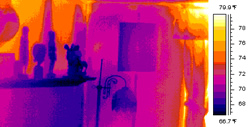
|
|
October 2006 |
Solving Moisture Problems in HUD Code Manufactured Housing Leads – Neil Moyer, Dave Chasar, David Beal (FSEC)
Over a five-year period, BAIHP researchers conducted diagnostic and systems evaluations in 98 moisture damage homes at the request of four home manufacturers. Most of the homes were less than a year old and thus still under warranty. These homes were on the brink of failure from moisture intrusion that the factory service teams could not resolve. Typically, service crews would have eliminated normal moisture problem sources such as plumbing and roof leaks and replaced materials at least once before requesting technical assistance from BAIHP. This represented tens of thousands of dollars in labor and material with the potential of having to replace the whole house if the problem remained unsolved. BAIHP researchers were able to pinpoint problems that service crews were unable to diagnose and then make recommendations for solving the root causes for the problems, often related to duct leakage, inadequate return air pathways, surfaces at extreme temperatures, and unexpected moisture sources. After BAIHP recommendations were implemented, manufacturers reported an overwhelming reduction in moisture problems achieved at a very low cost. BAIHP continues to work with manufacturers regarding crawl space moisture sources.
Once the service crews and managers saw and understood the building science techniques, they were eager to add them to their standard procedures, saving thousands of man-hours and dollars in avoided cost. BAIHP conducted field and classroom training in teaching the underlying building science principles as well as the practical skills. After the service teams were successful in using building science in existing houses, they communicated with factory managers the need to change the production processes to prevent recurrent moisture problems and associated service costs. Resources: The complete research paper can be viewed at: http://www.baihp.org/pubs/moistprob/index.htm.
|
